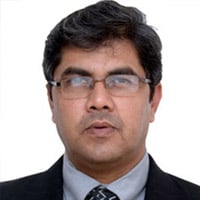

Before the era of optical fibre cables and high-speed Digital Subscriber Lines (DSL) or even freely available landlines, the IT industry in Hyderabad technically started with a satellite and line-of-sight high-speed microwave link. It started with J A Chowdary (JAC), whose vision helped create a miracle in our city. In a sleepy town where scheduled meetings usually happened at ‘Subah-Subah-Gyarah-Baje’ (Early in the morning at eleven am), an Indian technocrat mustered up the audacity to change shape-up the fortunes of a four-hundred-year-old city which went sleepy post-Indian Independence.
JAC was looking for a place to start the communications network, the technical backbone of the IT industry. For the technology of the day, a line-of-sight communication was the requirement; meaning an internet connection needed to see the antenna it would take/send the signal to, to operate. In the days of no google maps which also showed topographic information, it was all about trial and error to try digitally ‘connecting’. When on a meeting at MCRHRDI, Mr JAC noticed that he could see most of the then city of Hyderabad from a vantage point of being able to give out line-of-sight connections enabling internet rollout. The Government then allotted him some land next to the institute to start an internet landing and microwave connection facility to connect to companies.
A parallel question that he had to figure out was, to look for a place to start IT-companies. After much searching, he chanced upon ‘Mytrivanam’ in Ameerpet. Interestingly, eight floors of that public building were looking-to-be-occupied at that time. So he hired the eight floors. And there started India’s first business incubator. Most of the companies incubated during his time became big. They were all later acquired or at the least went on to be listed on NASDAQ.
With connected office-spaces and connectivity in place, the next in the jigsaw of the IT dream was the programmers/IT-Workers. There was an acute shortage of engineers/personnel. So, what people loving call Ameerpet-University now was where the people required to run the IT Dream came from. Aditya enclave, a business centre, was used to create classes that produced personnel trained in Mainframes, Lotus Notes, and the day’s software. Even to-date, the location of these training centres is the epicentre for the high-volume production of IT-technologists.
Digital-Connectivity, place, people and then the next question to solve software and equipment. It was not like today where you go on the Windows, Apple or Android and down a software that weighs gigabytes in a few minutes. With tight import controls and at the best a few hundreds of kilobytes connectivity, oxymoronically put, one had to import software in a hard form (floppies, CD’s or just systems loaded with software). Mr JAC then facilitated the importing of software. The barebones of the IT industry were created.
With Digital Connectivity, Place, People & Technology Hyderabad was ready to provide to the IT markets. It was then the market for services and Hyderabad that was missing. In the 1990’s COMDEX (Computer Dealers’ Exhibition) was the top international computer expo trade show which was held annually in Las Vegas, this is akin to the Consumer Electronics Show (CES) which we all know where the who-is-who of IT exhibit themselves. Brand Hyderabad was taken there by Mr JAC to be sold to the world. One of the most interesting questions that came was: Is Hyderabad in Pakistan? Other questions Mr JAC and his team encountered were: Are there direct international flights? Are there International schools for expats children? Ultimately… the last question–WAS THERE CRITICAL-MASS FOR THE IT INDUSTRY IN HYDERABAD?
Sadly there wasn’t. But the spirit of the then AP Government and the persuasion of Mr JAC finally ended up in Citi Bank setting up an office in Hyderabad. That started the ball rolling. Every company that approached Mr JAC or The-State or vice-versa was a project in itself. To untangle the quagmire of government regulation and mayhem, a single-window system was introduced. This was probably one of the first times such an initiative was taken-up in India.
The exciting times slowly rolled in. The Government selling the Brand-Hyderabad and companies up for setting up their presence in Hyderabad started the symbiosis. Some of the first companies to come and set up shop were by the NRI’s. The first wave of companies that came to Hyderabad were BPO’s. Higher end development and tech services felt a lack of software talent in Hyderabad when compared with Bangalore or other major metropolitan cities of the day. But with the seeds of high-volume-training sowed in institutes around Aditya Enclave, slowly but surely, started catering to the requirements of the Industry.
Several milestones in the journey of Hyderabad becoming an IT Hub are: The setting up of the satellite station for Internet in the late 1990’s; Setting up of high volume training centres in Aditya Enclave; Upsurge of business that came due to the Y2K issue; Companies like Satyam that took up business in Hyderabad took advantage of the Manpower that came out of these high volume training centres; Creation of the Software Technology Parks of India (STPI) model; AP government’s lead in E-governance initiatives like Mee-Seva and E-Seva; Local companies taking up and partnering in these e-governance programmes bringing up the digital profile of the state; US President Bill Clinton’s visit to Hyderabad and the visibility that it created; Setting up of Microsoft’s Development Centre in Hyderabad; Graduates from AP choosing engineering as their primary choice of graduation; NRI’s willing to relocate to Hyderabad and bring back with them high end skills and international exposure; Angel investment ecosystem & accelerators ushered in by the ISB-TIE partnership; And today after two decades, in the mid-2010s the creation of T-Hub.
Each of these milestones above was herculean and took immense commitment, dedication perseverance to conquer. What the future holds for Hyderabad’s IT industry, and all the ancillary industries which came up due to the success of IT in Hyderabad are stories to be explored in themselves.
Amir Ullah Khan and Raju Bhupathiraju, researchers at CRIDP

